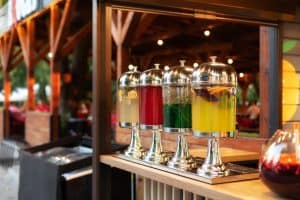
Vodka and whiskey are both alcoholic beverages, and they are frequently pitted against each other, despite the difference in the color of the drinks. Vodka traces back to Eastern Europe and Russia, while whiskey originated in Scotland.
These are just the top-of-the-head differences between the two, but it does not stop there. There is a long list of differences, unlike a few similar features of both liquors. So, what is the difference between Vodka and Whiskey?
Vodka is made from starch and sugar, usually from potatoes, by distillation, while whiskey is made from corn, rye, and barley and aged in wooden barrels. Also, vodka offers a swift and shorter effect, while whiskey provides a gradual and lengthier one.
Here, we will discuss fundamental differences between vodka and whiskey, their health effects, and a list of cocktails associated with both drinks.
Fundamental Differences Between Vodka and Whiskey

Vodka and whiskey are two of the most popular liquors in the world. They can both be made from fermented grain, but that’s about where the similarities end. Let’s take a closer look at the key differences between vodka and whiskey.
Process of Production
The process of making vodka and whiskey differs even though starting ingredients can be similar. Both vodka and whiskey need grains to start their making, but in the case of whiskey, the grains undergo malting coupled with distillation, and then it is aged in a barrel, anywhere between two-twenty years.
On the other hand, vodka does not need a malting process or aging, but starch in the starting product is the main requirement. You can distill the drink a few times and go straight to bottling.
The more vodka has been distilled, the less it contains impurities. So, even though the drink may come off as cleaner or concentrated, it can also mean that the starter ingredients used were of lower quality.
Flavor
The flavor of both drinks distinguishes them from each other quite clearly. Vodka has a neutral taste, which explains its use as a base for many blends. It is mainly tasteless and odorless, quite a plain drink, but still loved by many because of its smooth texture.
Whiskey, on the contrary, comes with a surplus of flavors. The flavor is dependent on the time it is aged in the barrel and the type of the base ingredient. Many describe its flavor as a little burning sensation in your mouth, but no whiskey tastes the same.
Percentage of Alcohol
Another distinctive feature is the percentage of alcohol present in both drinks. Vodka has a percentage range between 23.8% (lowest) to 40% (maximum) with roughly 60% water. Contrarily, whiskey packs a punch with an average range between 40-60%.
The lowest percentage for alcohol in the case of whiskey goes to Whyte & Mackye Light, clocking in at 21.5%, and the highest to Bruichladdich, with the mind-blowing percentage of 92% (lethal).
Hangover and Intoxication
If you want to avoid a severe hangover in the morning, always go for vodka.
The culprits behind the hangover are the by-products produced during the fermentation process, but as vodka is distilled several times, the impurities are removed, resulting in a milder hangover. Also, vodka can intoxicate you more quickly than whiskey.
As whiskey is not distilled more than once and is aged to heighten its flavor, it carries more by-products from fermentation. Whiskey does not intoxicate you as swiftly and takes a gradual effect, but it can cause a bad hangover.
Types
Based on the types of starter ingredients, vodka is subdivided into three small categories:
- Grain: This type involves using rye, barley, or wheat as a base material. They give a smoother and cleaner taste to the drink.
- Potato: It produces neutral taste alcohol, which is often a starter ingredient in many cocktails, and potato mash is the main ingredient in this category.
- Fruit: It involves using fruits as a base along with grains. The taste can vary from citrus to sweet, depending on the type of fruit.
Similar to vodka, whiskey is also of three subcategories:
- Rye: Rye is the starter for this type and has a sharp and spicy flavor.
- Bourbon: Corn is the base ingredient for making Bourbon, and it adds a caramel touch to the taste.
- Scotch: Usually made from barley, with a smoky texture, it is further broken down into single malt, blended malt, blended, and single-grain types.
Health Effects of Vodka and Whiskey

Like every other product, there are positive and adverse health effects associated with vodka and whiskey.
Pros
Vodka contains only alcohol and water and is devoid of sugar, which helps promote weight loss, and according to a study, vodka can help reduce stress. That is not all; it promotes heart health, remedies halitosis and toothache, and mitigates the pain of Arthritis.
Whiskey contains a list of ingredients that can help fight cancer, stop the progress of Alzheimer’s and Parkinson’s disease, prevent blood clotting in arteries, and reduce the risk of dementia.
Cons
Vodka and whiskey have similar cons, starting with heart issues, blood pressure problems, brain health damage, liver damage, heightened stress and anxiety, depression, sleep deprivation, increased lethargy, and weakening of the immune system.
That is why you should follow the recommended amount of one to two drinks per day for men and a maximum of one drink per day for women.
Vodka and Whiskey Cocktails

Vodka is a neutral spirit often used as a base for several cocktails, adding flavor to the drink. Here is a list of some most common vodka cocktails:
- Dirty Martini: This cocktail compliments the flavor of vodka with olives and vermouth. Its ingredients are 2.5 oz. of vodka, 0.5 oz. of vermouth, 0.5 oz. of olive juice, and olives on a skewer for garnish.
- The Moscow Mule: Vodka is mixed with ginger beer in this cocktail. Its ingredients are 2 oz. vodka, 4 oz. ginger beer, 0.5 oz. lemon juice, and lemon slices/mint leaf for garnishing.
- Bloody Mary: It provides a spicy tomato flavor to vodka. Its ingredients are complex, but the base ingredients are 1.5 oz. vodka, 3 oz. tomato juice, 0.5 oz. lemon juice, a pinch of salt and pepper, and two dashes of Worcestershire and Tabasco sauce.
Whiskey is preferred straight, but its types have found their application in several blends. The two most common are:
- Whiskey Sour: It adds a twist of lemon to bourbon whiskey. Its ingredients are 2 oz. of bourbon whiskey, 1 oz. lemon juice, simple syrup (to taste), and lemon slices for garnishing.
- Manhattan Whiskey: It is very bitter with a hint of sweetness. Its ingredients include 2 oz. rye whiskey, 1 oz. vermouth, 2 to 3 bitters, and a skewered cherry for garnishing.
Check out 10 creative whiskey cocktails here.
Summary
Finally, while Vodka and Whiskey share similarities at the beginning of making, their color, alcohol percent, effects, flavor, and process of making set them apart.
The choice of these drinks is subjective, but no matter which one you go for, keep your drinking habits under control and follow the recommended drinking amount to avoid any health complications.
Frequently Asked Questions
Whiskey is a strong drink, so take a whiff of your beverage and let your brain become aware of the taste. Then take a small sip, and swirl it in your mouth before ingesting it, which is the best way to enjoy your whiskey.
Yes, vodka has many other uses besides drinking. It can be used for cleaning purposes, as an aftershave (diluted), for stain removal, for the preservation of flowers in a vase, and so on; it is a handy drink to have at hand.









